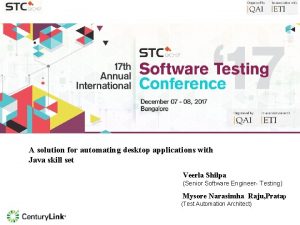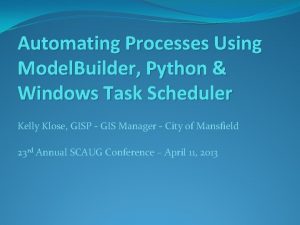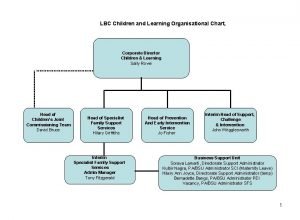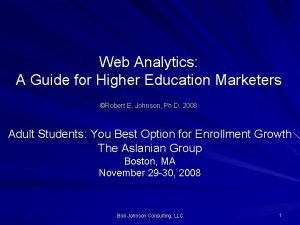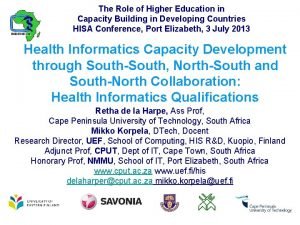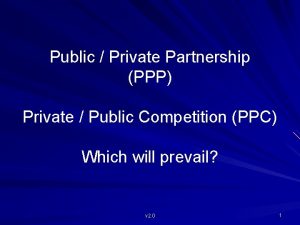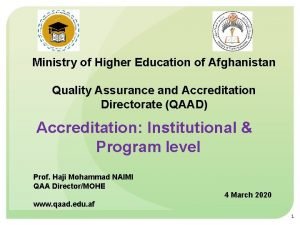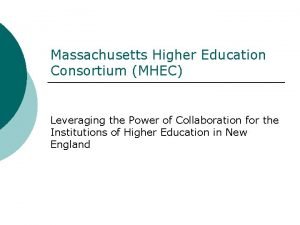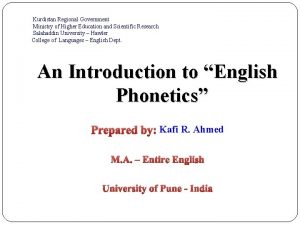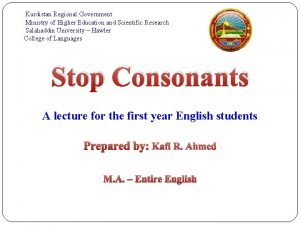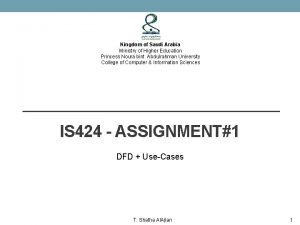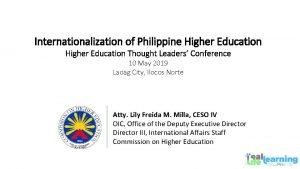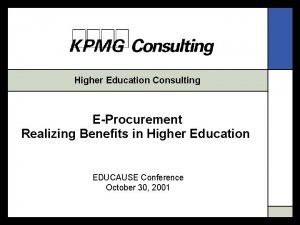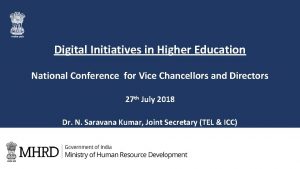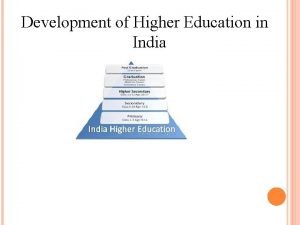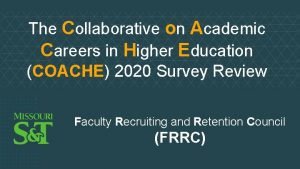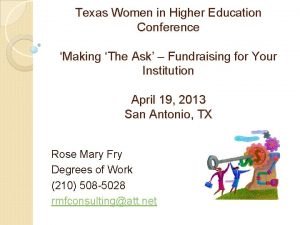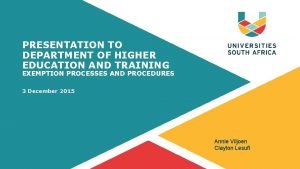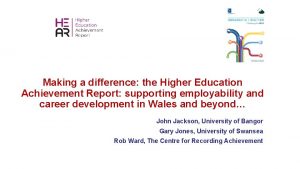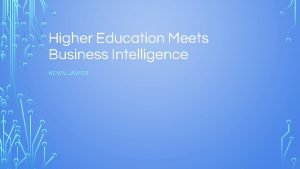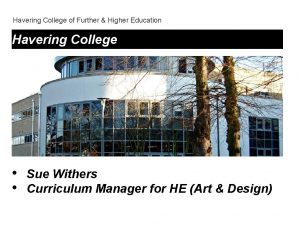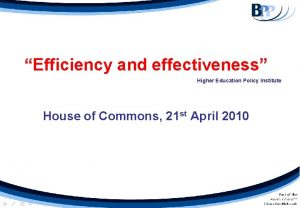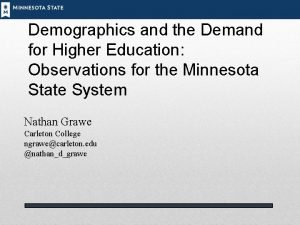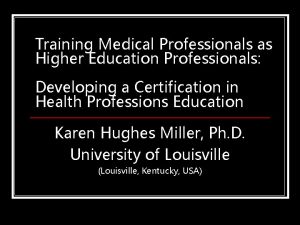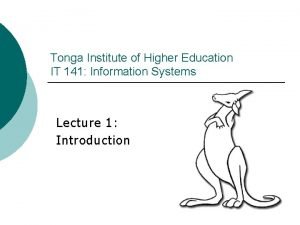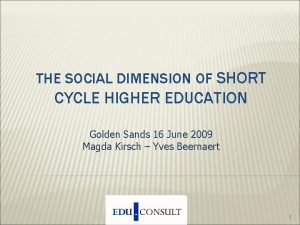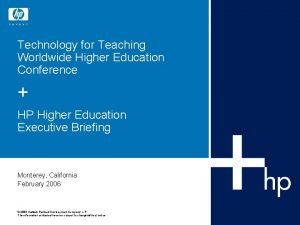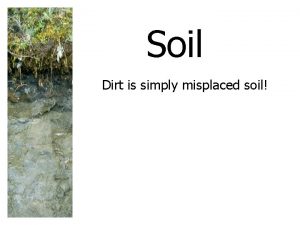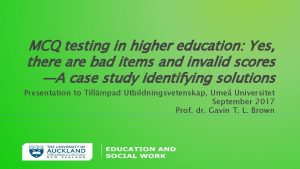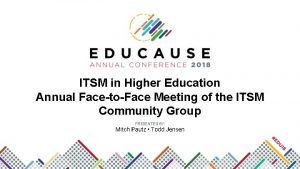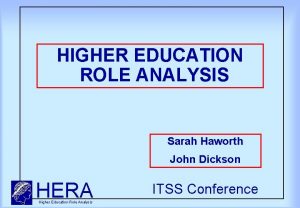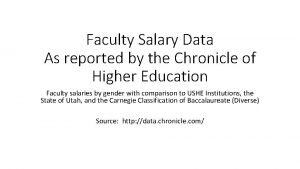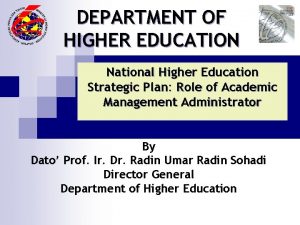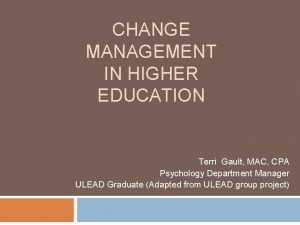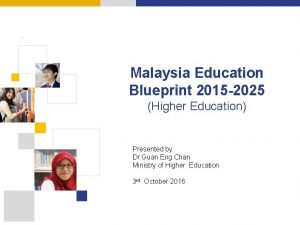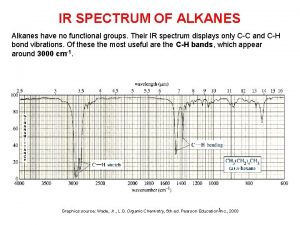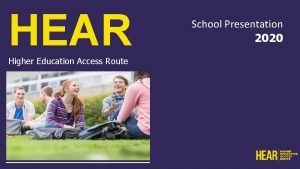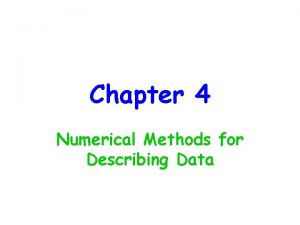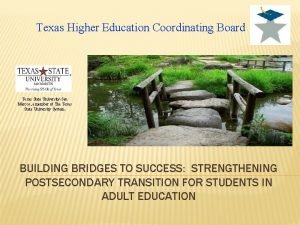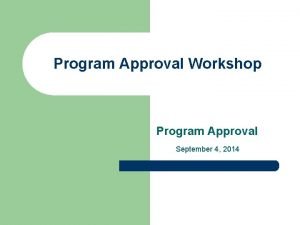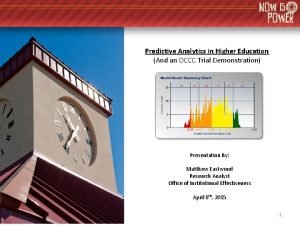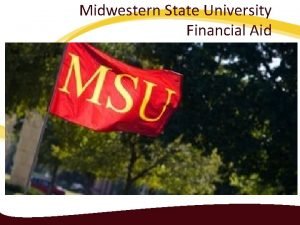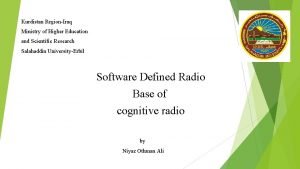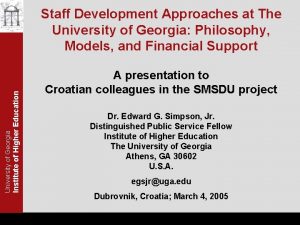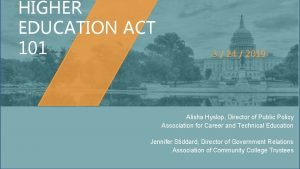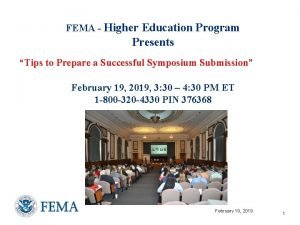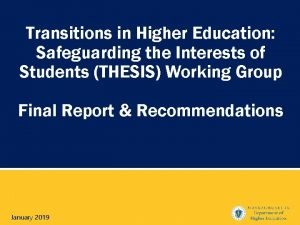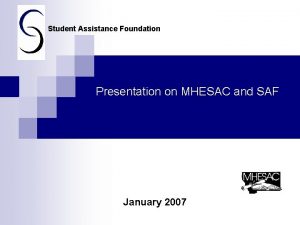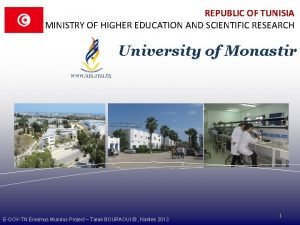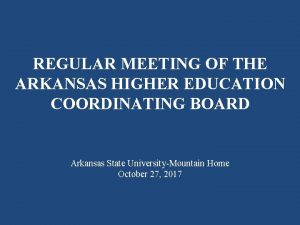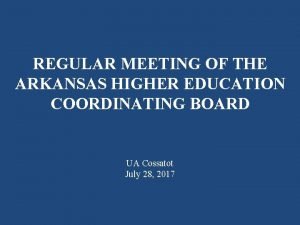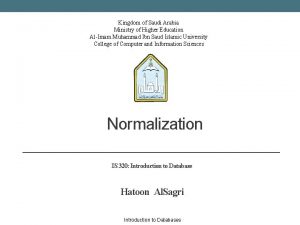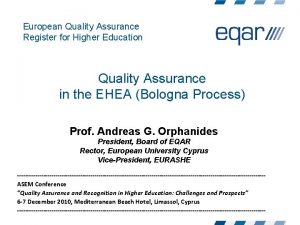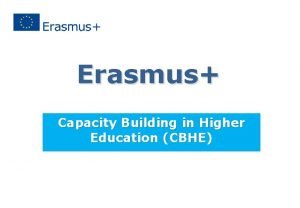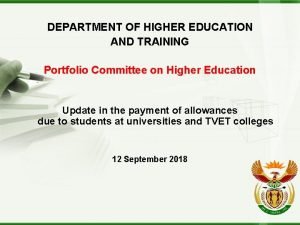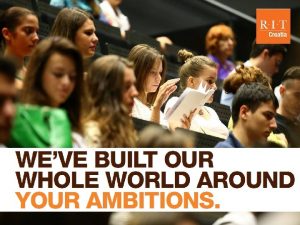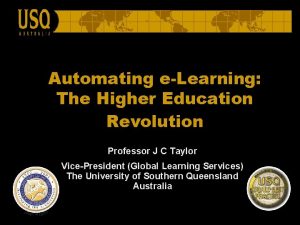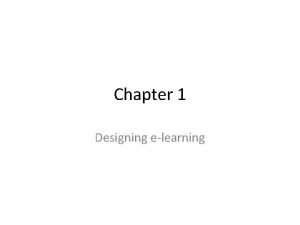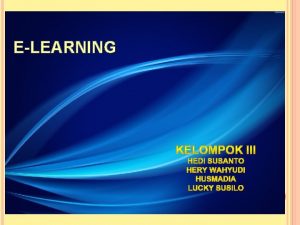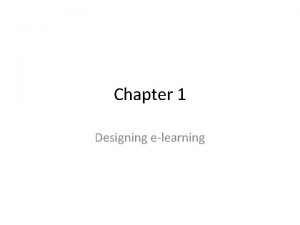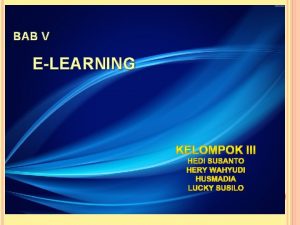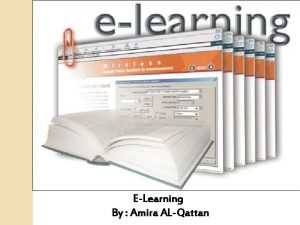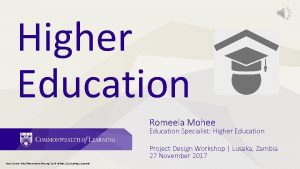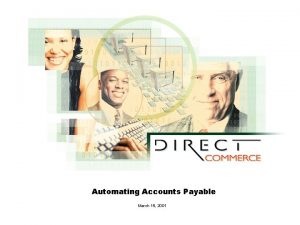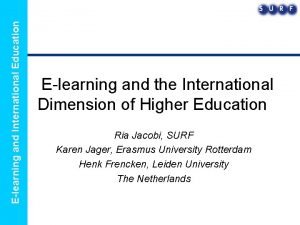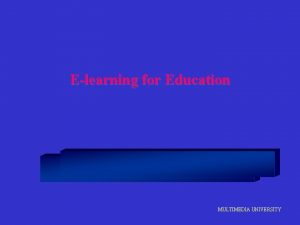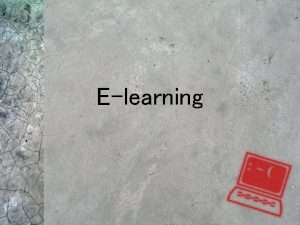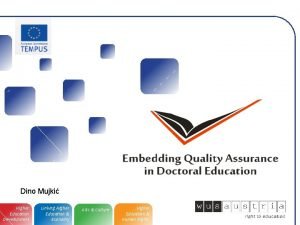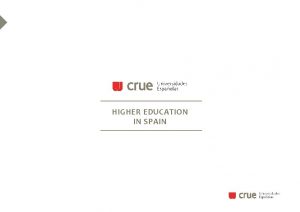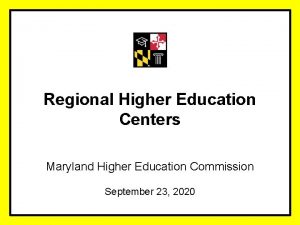Automating eLearning The Higher Education Revolution Professor J































































































- Slides: 95

Automating e-Learning: The Higher Education Revolution Professor J C Taylor Vice-President (Global Learning Services) The University of Southern Queensland Australia

1982 ICDE Conference in Vancouver: “Technology’s the answer, but what is the question? ” Today, the technology has changed, but the question hasn’t.

The Internet Powerful technical, economic and social trends facilitated by the Internet are revolutionizing the traditional concepts of business and economics – their effects on higher education will be especially profound.

Joseph Schumpeter (1934) predicted that every 50 years or so, technological revolutions would cause "gales of creative destruction” in which old industries would be swept away and replaced by new ones.

Technological Changes § Steam Power - 1780 s to the 1840 s § The Railways - 1840 s to the 1890 s § Electric Power - 1890 s to the 1930 s § The Motor Car - 1930 s to the 1980 s § Information Technology - 1980 s to ?

Pace of Change 1. Radio: 50 million users in 38 years 2. Television: 50 million users in 13 years 3. The Internet: 50 million users in 5 years Current prediction: One billion users by the year 2003

Internet Access Population (millions) § § § § § USA China 166. 0 56. 6 Japan Germany 51. 3 32. 2 UK South Korea Australia Hong Kong Singapore 29. 0 27. 8 10. 6 4. 4 2. 3 Total global population estimated at 498 million Source: A C Nielsen, March 2002

e-Readiness Rankings: Leaders e-Readiness ranking 1 2 3 4 5 6 7 8 9 10 11 12 13 Country USA Australia UK Canada Norway Sweden Singapore Finland Denmark Netherlands Switzerland Germany Hong Kong e-Readiness score 8. 73 8. 29 8. 10 8. 09 8. 07 7. 98 7. 87 7. 83 7. 70 7. 69 7. 67 7. 51 7. 45 Source: The Economist Intelligence Unit e. Business Forum, May 2001

e-Readiness Rankings: Contenders e-Readiness ranking 14 15 16 (tie) 18 19 20 21 22 23 24 25 Country Ireland France Austria Taiwan Japan Belgium New Zealand South Korea Italy Israel Spain Portugal e-Readiness score 7. 28 7. 26 7. 22 7. 18 7. 10 7. 00 6. 97 6. 74 6. 71 6. 43 6. 21 Source: The Economist Intelligence Unit e. Business Forum, May 2001

The EIU e-Readiness Rankings A formula based on the following factors: § Connectivity (30%) § Business environment (20%) § e-Commerce consumer & business adoption (20%) § Legal & regulatory environment (15%) § Supporting e-Services (10%) § Social & cultural infrastructure (5%) Source: http: //www. ebusinessforum. com

The Knowledge Explosion Over 90% of the relevant literature in many technical fields, such as biotechnology, astronomy, computers and software, and environmental sciences, has been produced since 1985. Traditional programmatic approaches to education simply cannot keep up………. . . J B Quinn (2001)

The Knowledge-based Economy There are increasing signs that our current paradigms for higher education, the nature of our academic programs, the organization of our colleges and universities, and the way that we finance, conduct and distribute the services of higher education may not be able to adapt to the demands of our time. J J Duderstadt (2001)

Prediction 'The death of distance as a determinant of the cost of communications will probably be the single most important economic force shaping society in the first half of the 21 st century'. Cairncross (1997)

Thesis Interaction between Internet systems and educational processes will revolutionize traditional approaches to higher education.

Leadership Challenge A market-driven restructuring of higher education as an industry – while perhaps both alien and distasteful to the academy – is an important perspective from which to view the future of universities.

Five Generations of Distance Education Technology § The Correspondence Model § The Multimedia Model § The Telelearning Model § The Flexible Learning Model § The Intelligent Flexible Learning Model

First Generation CHARACTERISTICS OF DELIVERY TECHNOLOGIESINSTITUTIONAL MODELS OF VARIABLE DISTANCE EDUCATION HIGHLY ADVANCED FLEXIBILITY COSTS AND ASSOCIATED REFINED INTERACTIVE APPROACHING ZERO DELIVERY TECHNOLOGIES Time Place Pace MATERIALS DELIVERY THE CORRESPONDENCE MODEL • Print Yes Yes No No

Second Generation CHARACTERISTICS OF DELIVERY TECHNOLOGIESINSTITUTIONAL MODELS OF VARIABLE DISTANCE EDUCATION HIGHLY ADVANCED FLEXIBILITY COSTS AND ASSOCIATED REFINED INTERACTIVE APPROACHING ZERO DELIVERY TECHNOLOGIES Time Place Pace MATERIALS DELIVERY THE MULTIMEDIA MODEL Yes Yes No No • Audiotape Yes Yes No No • Videotape Yes Yes No • Computer-based learning (eg CML/CAL) Yes Yes Yes No No • Interactive video Yes Yes Yes No • Print

Variable costs tend to increase or decrease directly (often linearly) with fluctuations in the volume of activity. In traditional distance education delivery, the distribution of packages of self-instructional materials (printed study guides, audiotapes, videotapes, etc) is a variable cost, which varies in direct proportion to the number of students enrolled.

Third Generation CHARACTERISTICS OF DELIVERY TECHNOLOGIESINSTITUTIONAL MODELS OF VARIABLE DISTANCE EDUCATION HIGHLY ADVANCED FLEXIBILITY COSTS AND ASSOCIATED REFINED INTERACTIVE APPROACHING ZERO DELIVERY TECHNOLOGIES Time Place Pace MATERIALS DELIVERY THE TELELEARNING MODEL • Audio-teleconferencing No No Yes No • Videoconferencing No No Yes • Audiographic communication No No No Yes No No • Broadcast TV/Radio and Audio-teleconferencing No No No Yes No

Fourth Generation CHARACTERISTICS OF DELIVERY TECHNOLOGIESINSTITUTIONAL MODELS OF VARIABLE DISTANCE EDUCATION HIGHLY ADVANCED FLEXIBILITY COSTS AND ASSOCIATED REFINED INTERACTIVEAPPROACHING ZERO DELIVERY TECHNOLOGIES Time Place Pace MATERIALS DELIVERY THE FLEXIBLE LEARNING MODEL • Interactive multimedia (IMM) Yes Yes Yes • Internet-based access to WWW resources Yes Yes Yes • Computer mediated communication (CMC). Yes Yes Yes No

Fifth Generation CHARACTERISTICS OF DELIVERY TECHNOLOGIESINSTITUTIONAL MODELS OF VARIABLE DISTANCE EDUCATION HIGHLY ADVANCED FLEXIBILITY COSTS AND ASSOCIATED REFINED INTERACTIVE APPROACHING ZERO DELIVERY TECHNOLOGIES Time Place Pace MATERIALS DELIVERY THE INTELLIGENT FLEXIBLE LEARNING MODEL • Interactive multimedia Yes Yes Yes • Internet-based access to WWW resources Yes Yes Yes • CMC, using automated response systems Yes Yes Yes • Campus portal access to institutional processes & resources Yes Yes Yes

Ask a question/ send an email NO Incoming “new” admin question from student Search / Match USQAssist: Self-service Knowledge Base Previous Questions Previous Answers “Immediate” admin feedback to student YES Trigger USQ staff member – “New Answer” 5 th Generation Application

Metadata Schema Model NO Duty Tutor Incoming “new” academic question from student Search / Match “Immediate” academic feedback to student Reusable Learning Objects Database Previous Questions <meta tags> Previous Answers <meta tags> New Answer YES Trigger 5 th Generation Application

Fast, Flexible and Fluid The transition from the Industrial to the Information Age was encapsulated by Dolence and Norris (1995), who argued that to survive organisations would need to change from rigid, formula driven entities to organisations that were “fast, flexible and fluid”.

Organisational Inertia Trying to change a university is like trying to move a graveyard --- it is extremely difficult and you don’t get much internal support.

Organisational Challenge Why should universities change? Increasing competition on a global scale.

Increasing Competition Unext (Business education only) § London School of Economics and Political Science § University of Chicago § Carnegie Mellon University § Columbia University § Stanford University

Increasing Competition Britain’s e-University The Higher Education Funding Council and the Department of Education and Employment has asked Treasury to provide an extra £ 100 million (approx. AU$300 million) to fund the e-University.

Increasing Competition The Cambridge e-MBA Cambridge University’s business school has joined forces with FT Knowledge, part of the global communications group Pearson plc, to offer this new degree from September 2001.

Fast, Flexible and Fluid? 791 years ago Cambridge University passed a rule Requiring all students to reside in the town of Cambridge, England. In 2000 that rule was revoked. The 800 year-old rulebook had to be altered to make way for the university’s first Internet-enabled program, the global e-MBA.

Increasing Competition All. Learn (an e-learning partnership between Oxford University, Stanford University and Yale University) is offering 75 short courses in a dozen disciplines in the Fall Semester, starting 7 th October, 2002 http: //www. alllearn. org

Increasing Competition UCLA’s Online. Learning. net § has enrolled over 20, 000 students in 1, 700 online courses since 1996. § Has offered student discounts, refer a friend gift certificates, frequent flyer points, opportunities to win free tuition.

Increasing Competition General Motors University now offers an e. MBA to provide online learning to as many as 86, 000 GM salaried employees.

Increasing Competition IBM’s Mindspan Solutions workplace and training systems employs 3, 000 people to develop customised e-learning content for 900 clients in 57 countries. (Source: K Dearne (2002), The Australian IT)

Increasing Competition University of Phoenix Online has 37, 600 students. It made a profit of $31. 8 million in 2001, and a profit of $23. 6 million in the first six months of 2002. Source: The Economist (2002)

The Big Picture § Change is the only constant. § Growth is the only certainty.

Future Projections § A recent IBM report forecasts a threefold (US$4. 5 trillion) jump in global education expenditure during the next 13 years. § The World Bank expects the number of higher education students will more than double from 70 million to 160 million by 2025. (Source: Richard Gluyas, New Nabs e-School Deal http: //finance. news. com. au, 22 April 2000).

Future Projections § By 2005, e-learning will be the single most used application on the web. § Corporate investment in e-learning will grow from US$2. 1 billion in 2001 to US$33. 4 billion in 2005. (Source: Harris, Logan & Lundy, Gartner Research, 2001).

The Global Lifelong Learning Economy What type of institutions will survive? Will your institution survive?


Enrolled Students USQ 2002 § § All students On-campus Off-campus (Australia) Off-campus (Overseas) 22, 024 5, 659 12, 010 4, 355 Note: Students studying solely online 714

USQ’s International Students 2002 § § § Singapore 1, 605 Malaysia 1, 198 Hong Kong 318 South Africa 204 United Arab Emirates 171 Japan 159 Pacific Islands 153 India 124 Canada 123 China 118 Germany 95 Total, incl. students from 95 other countries 5, 792

Bretten, Germany

Organisational Development In many universities the development of web-based initiatives is not systemic, but is often the result of random acts of innovation initiated by risktaking individual academics.

Organisational Development The implementation of education technologies including web-based applications at USQ is strategically planned, systematically integrated and institutionally comprehensive.

USQ: A guiding objective To be a leader in flexible learning and the use of information and communication technologies


Management Structure of Online Initiatives Faculties Academic Board Online Teaching Management Committee VCC Online Systems Management Committee Information Infrastructure and Services Committee Online Marketing Management Committee



XML (e. Xtensible Markup Language) RENDITIONS: Print STYLE SHEET: XSL Web CD DVD XSL XSL XML CONTENT REPOSITORY: INPUT: DTD (Document Type Definition) XML Editor




The PC-e. Phone





http: //www. usqonline. com. au

Using the Internet as a mode of delivery will not automatically improve student learning.

Laurillard (2002)…. . “ The academic world has called each new technological device – word processing, interactive video, hypertext, multimedia, the Webinto the service of the transmission model of learning. ”

The Potential of e-Learning § From transmission to transaction § From the independent learner to the inter-dependent learner












Communication Areas Content Areas Group Areas Student Areas

Computer Mediated Communication (CMC) There is a fundamental qualitative difference between a traditional oncampus tutorial and asynchronous written communication online.

Important Qualitative Difference Compared to the spontaneous and less structured nature of oral discourse, asynchronous discussion online engenders a disciplined and rigorous form of thinking based on the reflective and explicit nature of the written word.

Brown & Duguid (2000) emphasised the importance of regarding learning as a social act: “Practice is an effective teacher, and community of practice an ideal learning environment. ”

Relevant Instructional Design Theories § ZPD: Zone of proximal development (Vygotsky, 1978; 1981) § Reflective practitioner (Schon, 1987) § Communities of practice (Brown, Collins & Duguid, 1989) § Situated cognition (Lave & Wenger, 1991)

Lave & Wenger (1991) emphasised the importance of the social context in which the learner is immersed, and learning as legitimate peripheral participation in a community of practice.

In the online context, legitimate peripheral participation has become associated with the term “Lurker”. “One of the “silent majority” in an electronic forum; one who posts occasionally or not at all but is known to read the group's postings regularly. ” (The Jargon dictionary, 2002)

Is peripheral participation really legitimate? Are all lurkers illegitimate?

General Engagement Ratio of staff: student engagement in online teaching and learning. In course FET 8601, a ratio of 1: 8

Asynchronous Communication Engagement (ACE) Ratio of staff: student engagement in the discussion forum. In FET 8601, an ACE ratio of 1: 4

Student Participation Profiles § Proactive Workers § Peripheral Lurkers § Parsimonious Shirkers

Overview of Participation and Performance Student Sub. Groups Average Number: Discussion Board Hits Average Number: Messages Posted Average: GPA The Workers 193 38 5. 43 The Lurkers 129 13 5. 41 The Shirkers 36 4 4. 30

Outcome The academic performance of the lurkers was on average not much less than that of the workers, thereby supporting the notion of learning as legitimate peripheral participation.

The Future The success of the lurkers augurs well for the use of e-learning facilitated by intelligent databases and the flexibility inherent in interacting with virtual cohorts of students.

Metadata Schema Model NO Duty Tutor Incoming “new” academic question from student Search / Match “Immediate” academic feedback to student Reusable Learning Objects Database Previous Questions <meta tags> Previous Answers <meta tags> New Answer YES Trigger 5 th Generation Application

th 5 Generation As the intelligent databases become more comprehensive, the institutional variable costs for the provision of effective student support will tend towards zero.

5 th Generation In effect, fifth generation distance provides students with better quality tuition and more effective pedagogical and administrative support services at lower cost.

“Clicks and Mortar” are not enough The Internet is set to connect virtually everyone and everything – the Web is turning into humanity’s collective brain. Any organisation hoping to survive must mirror the Internet itself. It must become: open non-hierarchical democratic experimental tightly networked endlessly adaptable

“Clicks and Mortar” are not enough To survive and prosper organisations need to mirror the Internet and to develop a collective brain capable of - “habitual and radical innovation”. (Gary Hamel, Inside the Revolution, 2001)

The e-Revolution “Any new technology environment eventually creates a totally new human environment”. Marshall Mc. Luhan
 Promotion from assistant to associate professor
Promotion from assistant to associate professor Leanft vs selenium
Leanft vs selenium Desktop automation using python
Desktop automation using python Automating windows tasks with python
Automating windows tasks with python Russian revolution vs french revolution
Russian revolution vs french revolution Economic causes of french revolution
Economic causes of french revolution Third agricultural revolution
Third agricultural revolution Lbc organizational chart
Lbc organizational chart Web analytics for higher education
Web analytics for higher education Capacity building in the field of higher education
Capacity building in the field of higher education Importance of faculty in higher education
Importance of faculty in higher education Rhode island board of governors for higher education
Rhode island board of governors for higher education Higher education ppc
Higher education ppc Ministry of higher education afghanistan
Ministry of higher education afghanistan Massachusetts higher education consortium
Massachusetts higher education consortium Ministry of higher education kurdistan
Ministry of higher education kurdistan Kurdistan
Kurdistan Kurdistan higher education
Kurdistan higher education Ministry of higher education saudi arabia
Ministry of higher education saudi arabia Internationalization of higher education in the philippines
Internationalization of higher education in the philippines Higher education eprocurement
Higher education eprocurement Digital initiatives in higher education
Digital initiatives in higher education Gartner digital transformation in higher education
Gartner digital transformation in higher education Wood despatch 1854
Wood despatch 1854 Recommendations of yashpal committee report 1993
Recommendations of yashpal committee report 1993 Collaborative on academic careers in higher education
Collaborative on academic careers in higher education Texas women in higher education conference
Texas women in higher education conference Department of higher education and training
Department of higher education and training 2007 thomson higher education
2007 thomson higher education Higher education achievement report
Higher education achievement report Business intelligence in higher education
Business intelligence in higher education Higher education access tracker
Higher education access tracker Havering college of further and higher education
Havering college of further and higher education Efficiency and effectiveness in higher education
Efficiency and effectiveness in higher education Demographics and the demand for higher education
Demographics and the demand for higher education Higher education mauritius
Higher education mauritius Training for higher education professionals
Training for higher education professionals Tonga institute of higher education
Tonga institute of higher education Short cycle higher education
Short cycle higher education Fen ohen
Fen ohen Hp higher education
Hp higher education Thomson higher education 2007
Thomson higher education 2007 Quality of education can be impacted by mcq
Quality of education can be impacted by mcq Higher ed itsm
Higher ed itsm Higher education role analysis
Higher education role analysis Four segments of higher education
Four segments of higher education Chronicle faculty salaries
Chronicle faculty salaries National higher education strategic plan
National higher education strategic plan Change management in higher education
Change management in higher education Unit 5 higher education
Unit 5 higher education Malaysia education blueprint 2015 to 2025
Malaysia education blueprint 2015 to 2025 Ir spectrum of alkanes
Ir spectrum of alkanes Higher education access route
Higher education access route Numerical methods for describing data
Numerical methods for describing data Ccrs standards texas
Ccrs standards texas Texas higher education coordinating board
Texas higher education coordinating board Predictive analytics software for higher education
Predictive analytics software for higher education Webworld msu
Webworld msu Ministry of higher education erbil
Ministry of higher education erbil Uga institute of higher education
Uga institute of higher education Evaluate questions higher pe
Evaluate questions higher pe Jennifer stiddard
Jennifer stiddard Fema higher education
Fema higher education Safeguarding in higher education
Safeguarding in higher education Student assistance foundation
Student assistance foundation Ministry of higher education tunisia
Ministry of higher education tunisia Arkansas higher education coordinating board
Arkansas higher education coordinating board Arkansas higher education coordinating board
Arkansas higher education coordinating board Ministry of higher education saudi arabia
Ministry of higher education saudi arabia Salt river higher education
Salt river higher education European quality assurance agency
European quality assurance agency Erasmus+ capacity building in higher education
Erasmus+ capacity building in higher education Portfolio committee on higher education
Portfolio committee on higher education Chu hai college of higher education
Chu hai college of higher education Middle states commision on higher education
Middle states commision on higher education Hát kết hợp bộ gõ cơ thể
Hát kết hợp bộ gõ cơ thể Ng-html
Ng-html Bổ thể
Bổ thể Tỉ lệ cơ thể trẻ em
Tỉ lệ cơ thể trẻ em Chó sói
Chó sói Tư thế worm breton
Tư thế worm breton Chúa yêu trần thế alleluia
Chúa yêu trần thế alleluia Kể tên các môn thể thao
Kể tên các môn thể thao Thế nào là hệ số cao nhất
Thế nào là hệ số cao nhất Các châu lục và đại dương trên thế giới
Các châu lục và đại dương trên thế giới Công thức tính thế năng
Công thức tính thế năng Trời xanh đây là của chúng ta thể thơ
Trời xanh đây là của chúng ta thể thơ Cách giải mật thư tọa độ
Cách giải mật thư tọa độ Làm thế nào để 102-1=99
Làm thế nào để 102-1=99 độ dài liên kết
độ dài liên kết Các châu lục và đại dương trên thế giới
Các châu lục và đại dương trên thế giới Thể thơ truyền thống
Thể thơ truyền thống Quá trình desamine hóa có thể tạo ra
Quá trình desamine hóa có thể tạo ra Một số thể thơ truyền thống
Một số thể thơ truyền thống Cái miệng nó xinh thế chỉ nói điều hay thôi
Cái miệng nó xinh thế chỉ nói điều hay thôi Vẽ hình chiếu vuông góc của vật thể sau
Vẽ hình chiếu vuông góc của vật thể sau

